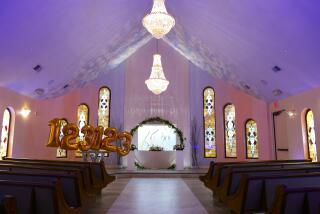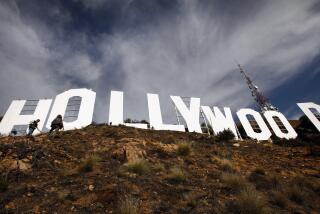‘First Night’ Is New Legacy to Usher Out the Old Year
- Share via
BOSTON — What if they gave a New Year’s Eve party and the whole town came?
Basically, that’s what has happened here since 1976, when the country’s first “First Night” celebration was staged. The tradition took hold, so much so that this city of about 600,000 residents expects 2 million people to show up for First Night 1999.
And following Boston’s lead, more than 250 communities in the United States, Canada, Britain and New Zealand have adopted the idea of a city-sponsored festival as an alternative to raucous revelry where people drink too much, wear silly hats and then suffer from horrible New Year’s letdown.
First Night here is officially an alcohol-free celebration intended to attract singles, couples and families, with all ages and ethnicities. The focus is on the arts, including musical and dramatic performances in historic churches and a procession that snakes across Boston Common and through streets that are often covered with snow. Civic plazas become the settings for ice sculptures, poetry contests and Scottish dancing demonstrations. An extravagant laser-in-the-sky show depicts familiar sights, such as Boston’s swan boats and the John Hancock tower. Crime goes down, public transportation is free and a $12 button admits First Night celebrators to all indoor events.
“On one level, the First Night festival is an opportunity for folks of diverse backgrounds to get together and have a great party,” said Eric Bornstein, a mask maker whose Behind the Mask Theater players will march in the opening procession, just behind the police, the mayor and the city’s storyteller laureate, Brother Blue. “On the other hand, it fulfills a need, a place in our hearts--something that has been recognized in other parts of the world for centuries: You need a renewal ritual.”
Fullerton, Escondido and San Diego are among at least 10 California cities that have borrowed the concept.
Night’s Camaraderie Strikes a Chord
The First Night spirit has spread, said Zeren Earls, an art educator, because “once people began walking the streets of Boston and seeing the camaraderie, the fact that strangers were wishing each other happy New Year--that struck a chord because that’s rare in this day and age where you hardly know your neighbors.” Earls now directs the nonprofit First Night International, which advises communities about setting up these celebrations.
First Night themes vary from region to region and from year to year. Last year, Binghamton, N.Y., paid homage to its heritage as a center of the shoe industry. The town commissioned a modern dance piece about shoes, store fronts were transformed to resemble old shoe factories and children got involved, some portraying immigrants who had been brought to Binghamton to manufacture shoes. In California, Monterey this year will pay tribute to the 150th anniversary of the Gold Rush. Bloomsburg, Pa., invites all “New Year’s babies”--people born on Jan. 1, regardless of the year--to lead its opening procession.
The First Night concept dates back to 1975, when Clara Wainwright, a quilt maker and longtime resident of Boston’s Back Bay district, invited a group of friends to dinner. Weeks earlier, Wainwright had turned down an invitation to spend New Year’s Eve with a bell ringer at Harvard University. Instead, Wainwright trooped off to a party with a bunch of artists.
“It turned out to be just as stupid as all the rest,” she recalled.
But Wainwright’s bell-ringing buddy had offered an idle remark that stuck with her. “Isn’t it too bad that the city doesn’t do anything official about New Year’s Eve?” he asked.
Wainwright was of the firm belief that “many people would agree that New Year’s Eve is one of the more inane kind of holidays.” But when she invited her friends--including two artists, a composer, a psychiatrist and a woman who was running Boston’s Bicentennial celebration--to brainstorm about how to reinvent New Year’s, wondrous possibilities emerged.
Guests Offer Many Ideas
One guest said the churches should be the social center of the city, as they were when Boston began. Another said the occasion should be for families, not just for lovers. Someone else suggested that artists should serve as liaisons to translate the strange emotions and spirits that are afoot on New Year’s Eve. The psychiatrist said, “We should blur the distinction between the observer and that which is observed.”
The next day, Wainwright called a man who headed several large foundations. Over the phone, he made a generous commitment. Then she called an executive. He too immediately offered to put up money and pull together a group of corporate leaders. City officials were no less enthusiastic. Though it was only 6 degrees outside when First Night--so named because it celebrates the start of a new year--made its 1976 debut, warm sentiments prevailed. Babies in blankets bobbed in backpacks. Ice sculptors rejoiced: For once, a user-friendly venue for their works. The city became the stage, Wainwright said, and all the players reveled.
“Everyone you passed spoke to you,” she said. “It was like being back when Boston was a young city.”
In their infinite optimism, the early architects of First Night fantasized that one day an airline passenger might fly from coast to coast on New Year’s Eve and see a string of public celebrations. The idea was not unlike the traditional carnivals that have existed in Europe for centuries. For one night a year, whole cities could stop working and just have a grand time.
By now, First Night has become an institution in Boston. Private foundations, corporate sponsors, government funding and proceeds from the admission button now account for the $2.5-million budget of First Night Boston, a nonprofit organization that runs year-round.
Most People Walk, Ride Public Transit
In the spirit of the event, most people either walk or take public transit to sample a half dozen or more performances or events all around this compact city. The 1999 First Night will showcase more than 1,000 artists, as well as 250 performances in 45 indoor and outdoor locations around the city.
Artists must apply to participate. If a proposal is accepted, the artist receives a stipend to cover materials.
But “nobody gets rich,” said Bornstein, who spends about six months preparing 25 phantasmagoric masks. Each mask consumes between 50 and 100 hours of labor, Bornstein said. His masked troupe--featuring a factory worker, a Harvard student, a Harley biker and an electronics genius--all but personifies First Night’s mood of inclusiveness.
Already, First Night officials say, inquiries have poured in about plans for First Night 2000. This city could well become a millennium destination, they predict, making the urban New Year’s festival a legacy for the new century.
More to Read
Sign up for The Wild
We’ll help you find the best places to hike, bike and run, as well as the perfect silent spots for meditation and yoga.
You may occasionally receive promotional content from the Los Angeles Times.






